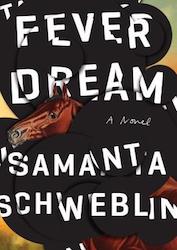
I have read two short translated novels this month, The Vegetarian, a Korean novel by Han Kang and now Fever Dream, a Spanish novel by Samanta Schweblin. Never have I been more confused.
I’ve already written about The Vegetarian, so let’s see what I can make of Fever Dream. The entire novel is a dialogue of sorts between a woman named Amanda, who apparently is in a medical clinic in a vacation town outside of her home city Buenos Aires, and a young boy named David, the son of Amanda’s neighbor, Carla.
It’s impossible to know if it’s a real dialogue, an imagined one (if Carla is terminally ill and this is all a “fever dream”), or something even more supernatural.
Then it gets complicated further by the introduction of Carla’s story, which David has asked Amanda to recount for him–a story Carla tells Amanda from six years ago when David was poisoned by water from the nearby stream and nearly died. To save him, Carla takes David to a psychic who splits his soul and sends part of it somewhere else, to lessen the effects of the poison.
Has Amanda been poisoned now the same way? Has her daughter Nina? What is the poison? Is it an actual poison, or is it a part of the landscape and this whole book is a cautionary tale about genetically-modified crops and agriculture? Who knows?
The prose is laid out in such a way that the tension of the narrative constantly increases. Each thing Amanda learns is more terrible than the last, and it keeps driving toward a destination it never reaches. Absolutely nothing is resolved for the reader in the end, leaving the entire experience ambiguous and, for me, frustrating and unsatisfying. Perhaps it’s intentional; I don’t know. But now I have two books hanging over my head that I’m never going to understand.
I’ve already written about The Vegetarian, so let’s see what I can make of Fever Dream. The entire novel is a dialogue of sorts between a woman named Amanda, who apparently is in a medical clinic in a vacation town outside of her home city Buenos Aires, and a young boy named David, the son of Amanda’s neighbor, Carla.
It’s impossible to know if it’s a real dialogue, an imagined one (if Carla is terminally ill and this is all a “fever dream”), or something even more supernatural.
Then it gets complicated further by the introduction of Carla’s story, which David has asked Amanda to recount for him–a story Carla tells Amanda from six years ago when David was poisoned by water from the nearby stream and nearly died. To save him, Carla takes David to a psychic who splits his soul and sends part of it somewhere else, to lessen the effects of the poison.
Has Amanda been poisoned now the same way? Has her daughter Nina? What is the poison? Is it an actual poison, or is it a part of the landscape and this whole book is a cautionary tale about genetically-modified crops and agriculture? Who knows?
The prose is laid out in such a way that the tension of the narrative constantly increases. Each thing Amanda learns is more terrible than the last, and it keeps driving toward a destination it never reaches. Absolutely nothing is resolved for the reader in the end, leaving the entire experience ambiguous and, for me, frustrating and unsatisfying. Perhaps it’s intentional; I don’t know. But now I have two books hanging over my head that I’m never going to understand.
 RSS Feed
RSS Feed
